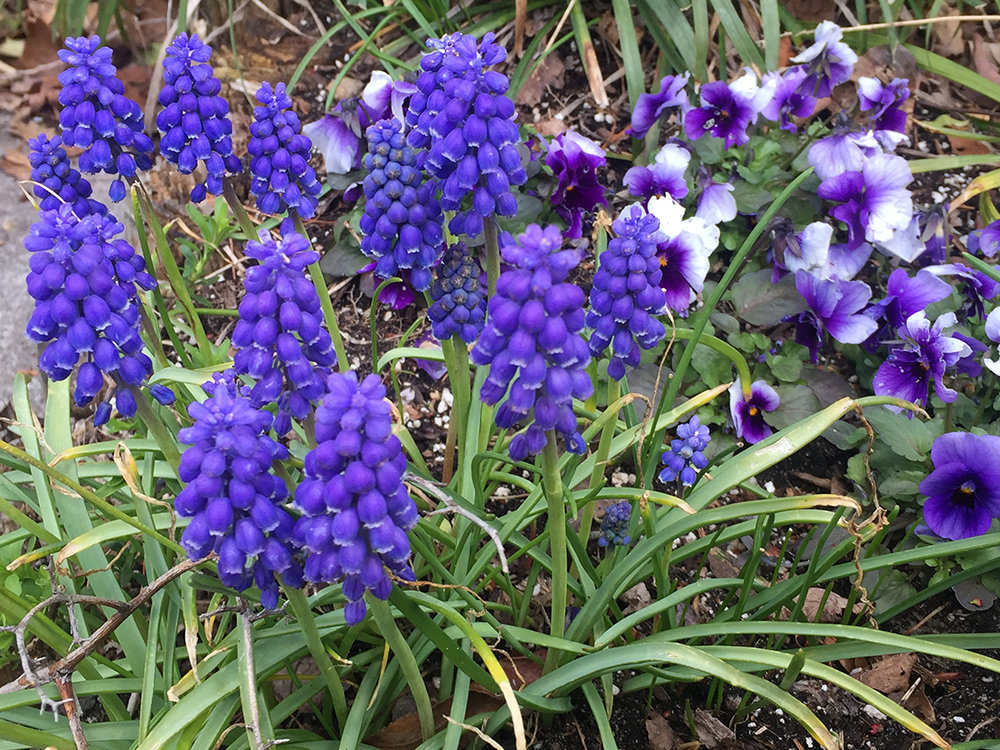Let It Grow
By Tammy Thornton
Spring has proclaimed itself loud and clear with refreshingly-warm sunny days, flowers joyfully bursting open, chilly nights to keep us mindful, and a few April showers thrown in for good measure. ‘Tis the season of hope and renewal.
If you planted flower bulbs in the fall, you are now reaping the rewards of your labor—and patient waiting! Daffodils are the great harbingers of spring, making the announcement with their trumpet-shaped flowers. But, for me, spring feels real when the grape hyacinths (muscari) begin to show their tiny little clustered cone-heads. I’m always smitten by these flowers, perhaps because they are blue—my favorite color. Their small spikes of blue flowers behave as a neutral color, complementing most other spring flowers such as red tulips, yellow daffodils, or pink ranunculus. Blue grape hyacinths are the most popular, but they can also be found in pink, yellow, or white.
Though they share a name with hyacinths, muscari are not true hyacinths. However, they do share the coveted trait of being deer-resistant, due to their scent. Never say never because a desperate animal might forget to read the gardening books about what they aren’t supposed to eat. But for the most part, hyacinths and grape hyacinths should be safe from deer, squirrels, rabbits and other nibblers in your garden.
While grape hyacinths grow best outdoors, I can’t resist adding a few to my spring and Easter decorations inside. Their dainty flowers look so pretty in a miniature display. One should always use caution with pets when bringing plants and flowers into your home. But, fortunately, the ASPCA lists grape hyacinths as non-toxic to dogs, cats, and horses (in case you have any of those wandering around your dining room). Grape hyacinth flowers and buds are also non-toxic for people. You could add a bit of color and fun to your salad, cake, or lemonade with a few grape hyacinth flowers, which are said to be high in Vitamin C and antioxidants. Please note this only applies to grape hyacinths. Do not eat regular hyacinths or leave them near your pets since this type of hyacinth can be toxic.
Taking a trip back outdoors to the garden, you may find that over time your grape hyacinths will spread and naturalize throughout the garden or into your yard with a lovely effect. If these little blue flowers pop up in an undesirable location, they are easy to dig up and move with a trowel. Just make sure you dig deep enough to get all of the bulb and roots. After blooming, the flowers will produce tiny, black seeds that may grow and spread naturally. You can collect the seeds to control where they grow. However, the seeds will need to be subjected to a period of dormancy and cold stratification to grow successfully. You can also propagate your grape hyacinths by digging them up and separating the bulbs that have produced offshoots.
Once you are smitten with these cute but hardly little flowers, you’ll want to make a mental note to plant more bulbs in the fall. Pretty soon you too will be feeling the blues, but only in the best sort of way possible.
Shore Local News would love to hear from our readers. What’s your favorite spring flower? Send your pictures, comments, and questions to: shorelocalgardener@gmail.com.
Tammy Thornton lives with her husband, children, and crazy pets while enjoying a life of gardening, cooking, and going to the beach.





